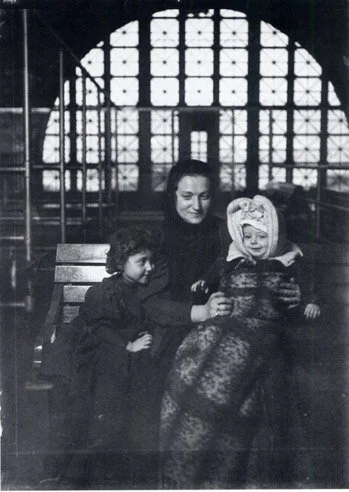“Our Strength Is Our People”: The humanist photographs of Lewis Hine
This recently-expanded exhibition is a survey of the life’s work of Lewis Wickes Hine (1874-1940), the father of American documentary photography. Trained as a sociologist at the University of Chicago, NYU, and Columbia University, Hine became a high school teacher at New York’s Ethical Culture School, a bastion of progressive education. At the time, the roiling political issue was immigration – much as it is today. Conservatives viewed immigration as a source of crime, disease, and the loss of America’s essential Anglo-Saxon character, whereas Progressives saw America as a melting pot, a beacon of light for foreigners escaping poverty and tyranny. Armed with a clumsy large-format view camera and magnesium flash, Hine took his students to Ellis Island in 1905 and put a human face on the “huddled masses yearning to breathe free.”
Sadie, a cotton mill spinner, Lancaster, South Carolina, 1908
Powerhouse Mechanic, 1920-21
Topping the mast, Empire State Building, 1931
Tire maker at the control wheel, 1930
Joys & Sorrows of Ellis Island: Happy Bohemian Mother, 1905
The Madonna of Ellis Island (Russian family), ca. 1905
Scrublady, New York, 1920
Young German steel worker, Pittsburgh, 1908
Italian immigrant from Albania, Ellis Island, ca. 1905
Stevedores take time off for a much needed noon rest, New York City, ca. 1922
Carrying-in boy, glassworks, Alexandria, Virginia, 1909
Newsies at Brooklyn Bridge Starting Out at 1 a.m. in a Blizzard on a Sunday, 1908
Italian family looking for lost baggage, Ellis Island, 1905
Little Orphan Annie in a Pittsburgh Institution, 1908
Glazier, Miniature Incandescent Lamp Corporation, ca. 1920
Paris Gamin (from the American Red Cross Survey), ca. 1918
Woman at a modern automatic silk loom, New Jersey, 1921
Steelworkers at Russian boarding house, Homestead, Pennsylvania, ca. 1907
Young Boy, Steelworker, Pittsburgh, ca. 1908
Women painting decorative glass tumblers, ca.1920
German steel worker, Pittsburgh, ca. 1908
© Lewis Hine
Hine’s empathetic interest in the immigrant experience did not end at Ellis Island. In 1907 he joined the Pittsburgh Survey, a comprehensive socioeconomic analysis of a typical industrial city in America’s heartland. As seen through Hine’s lens, the steel that supplied the backbone of America’s industry was being forged by immigrants – the Italian and the Irish, the Serb and the Slovak, now proud Americans. Hine’s focus on the dignity of the American worker would last a quarter century, culminating in his magnificent photographs of the construction of the Empire State Building in 1931 and in the classic book Men at Work. His oeuvre is the humanist counterpoint to the avant garde art world’s fixation on the machine as the emblem of the modern age.
To Hine, however, labor was a double-edged sword. In the service of unchecked laissez-faire capitalism, it could be physically and emotionally debilitating, dehumanizing rather than empowering – never more so than when minor children are deprived of their childhoods and put to work in the factories and the field. Starting in 1908, Hine worked for the National Child Labor Committee, sneaking his camera into cotton mills, canning companies, and glassworks to document the exploitation of children, always under false pretenses and often at great personal risk. Hine’s heart-rending images of underage labor were the principal tool used by the NCLC to lobby state-by-state for child labor laws, until Congress finally outlawed the practice at the national level in 1938.
That year, Hine applied for a Guggenheim fellowship. His proposed project was entitled “Our Strength is Our People,” from which our exhibition title is borrowed. His proposal stated:
“This project should give us light on the kinds of strength we have to build upon as a nation. Much emphasis is being put upon the dangers inherent in our alien groups, our unassimilated or even partly Americanized citizens – criticism based upon insufficient knowledge. A corrective for this would be better facilities for seeing, and so understanding, what the facts are.”
Inexplicably, the Guggenheim Foundation turned him down.
Two years later, Hine, the epitome of the “concerned photographer,” died penniless and on welfare, his beloved wife Sara dead of pneumonia, his house lost to foreclosure. But today, over 80 years after his death, Hine’s photographic achievement lives on, an unblinking composite portrait of America the melting pot, a country beset by grave injustices, yet always a beacon of hope.
“Our Strength Is Our People”: The humanist photographs of Lewis Hine consists entirely of rare vintage or early prints, which are the purest expression of Hine’s lasting vision. Fifteen of these are master exhibition prints in the astonishing 16x20 inch size.
Number of photographs: 74
Frame sizes: various from 11x14 to 24x28 inches
Rental fee: $15,000 for eight weeks plus shipping and insurance. Additional weeks are available at 10 percent per week.
Press:





















